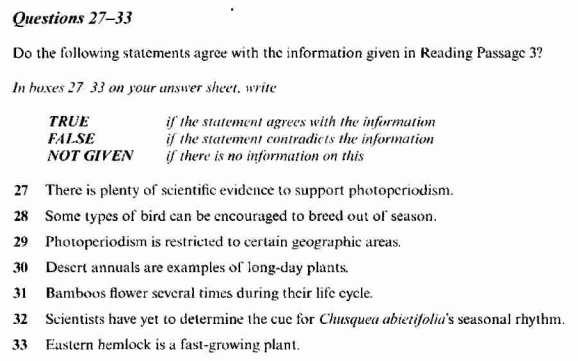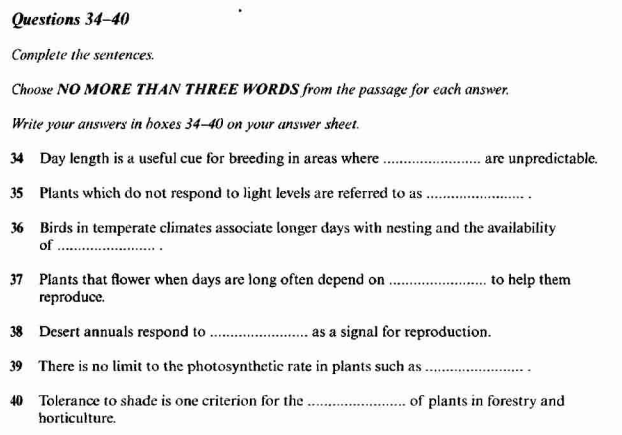剑桥雅思5:Test4雅思阅读PASSAGE 3真题+答案+解析
发布时间:2020-11-02 关键词:剑桥雅思5:Test4雅思阅读PASSAGE 3真题+答案+解析为帮助同学们学习,小编为大家整理了剑桥雅思5:Test4雅思阅读PASSAGE 3真题+答案+解析,希望能够对大家有帮助。关于剑桥雅思的资讯关注新航道北京学校剑桥雅思栏目。
READING PASSAGE 3
You should spend about 20 minutes on Questions 27- 40, which are based on Reading Passage 3below.
The effects of light on plant and animal species
Light is important to organisms for two different reasons. Firstly it is used as a cue for thetiming of daily and seasonal rhythms in both plants and animals, and secondly it is used toassist growth in plants.
Breeding in most organisms occurs during a part of the year only, and so a reliable cue isneeded to trigger breeding behaviour. Day length is an excellent cue, because it provides aperfectly predictable pattern of change within the year. In the temperate zone in spring,
temperatures fluctuate greatly from day to day, but day length increases steadily by a
predictable amount. The seasonal impact of day length on physiological responses is calledphotoperiodism, and the amount of experimental evidence for this phenomenon is
considerable. For example, some species of birds' breeding can be induced even in midwintersimply by increasing day length artificially (Wolfson 1964). Other examples of photoperiodismoccur in plants. A short-day plant flowers when the day is less than a certain critical length. Along-day plant flowers after a certain critical day length is exceeded. In both cases the criticalday length differs from species to species. Plants which flower after a period of vegetativegrowth, regardless of photoperiod, are known as day-neutral plants,
Breeding seasons in animals such as birds have evolved to occupy the part of the year in
which offspring have the greatest chances of survival. Before the breeding season begins, foodreserves must be built up to support the energy cost of reproduction, and to provide for
young birds both when they are in the nest and after fledging. Thus many temperate -zonebirds use the increasing day lengths in spring as a cue to begin the nesting cycle, because thisis a point when adequate food resources will be assured.
The adaptive significance of photoperiodism in plants is also clear. Short-day plants that
flower in spring in the temperate zone are adapted to maximising seedling growth during thegrowing season. Long-day plants are adapted for situations that require fertilization by insects,or a long period of seed ripening. Short-day plants that flower in the autumn in the
temperate zone are able to build up food reserves over the growing season and over winteras seeds, Day-neutral plants have an evolutionary advantage when the connection betweenthe favourable period for reproduction and day length is much less certain. For example,
desert annuals germinate, flower and seed whenever suitable rainfall occurs, regardless of theday length.
The breeding season of some plants can be delayed to extraordinary lengths. Bamboos areperennial grasses that remain in a vegetative state for many years and then suddenly flower,fruit and die (Evans 1976). Every bamboo of the species Chusquea abietifolia on the island
of Jamaica flowered, set seed and died during I 884. The next generation of bamboo floweredand died between 1916 and 1918, which suggests a vegetative cycle of about3l years. Theclimatic trigger for this flowering cycle is not yet known, but the adaptive significance is clear.The simultaneous production of masses of bamboo seeds (in some cases lying12 to 15
centimetres deep on the ground) is more than all the seed-eating animals can cope with atthe time, so that some seeds escape being eaten and grow up to form the next generation(Evans 1976).
The second reason light is important to organisms is that it is essential for photosynthesis. Thisis the process by which plants use energy from the sun to convert carbon from soil or waterinto organic material for growth. The rate of photosynthesis in a plant can be measured bycalculating the rate of its uptake of carbon. There is a wide range of photosynthetic
responses of plants to variations in light intensity. Some plants reach maximal photosynthesisat one-quarter full sunlight, and others, like sugarcane, never reach a maximum, but continueto increase photosynthesis rate as light intensity rises.
Plants in general can be divided into two groups: shade -tolerant species and shade inolerantspecies. This classification is commonly used in forestry and horticulture. Shade tolerantplants have lower photosynthetic rates and hence have lower growth rates than those ofshade-intolerant species. Plant species become adapted to living in a certain kind of habitat,and in the process evolve a series of characteristics that prevent them from occupying otherhabitats. Grime (1966) suggests that light may be one of the major components directingthese adaptations. For example, eastern hemlock seedlings are shade-tolerant. They can
survive in the forest understorey under very low light levels because they have a low photosynthetic rate.
READING PASSAGE 3 翻译
你应该花20分钟回答27- 40题,这些问题基于下面阅读文章3。
光对植物和动物的影响
光对生物体很重要有两个原因。首先,它被用作植物和动物每天和季节节律的时间线索,其次,它被用来帮助植物生长。
大多数生物体的繁殖只发生在一年中的一部分时间,因此需要一个可靠的线索来触发繁殖行为。昼长是一个的线索,因为它能地预测一年内的变化。春天在温带,
气温每天都有很大的波动,但白天的长度却以a的速度稳步增加
可预测的数量。日照长度对生理反应的季节性影响称为光周期现象,这一现象的实验证据数量为
可观的。例如,一些鸟类的繁殖甚至可以通过人工增加白天的长度来诱导(Wolfson 1964)。植物中光周期拟怜柯的其他例子。短日植物在白天小于某一临界长度时开花。长日植物花超过的关键天长度后。在这两种情况下,临界日长度因种而异。经过一段植物生长期而开花的植物,不论光周期如何,都被称为日中性植物。
鸟类等动物的繁殖季节已经进化到占据一年中的一部分时间
哪些后代有的生存机会在繁殖季节开始之前,食物必须建立起来,以支持繁殖的能量消耗,并提供
雏鸟在巢里的时候和刚出生的时候都是这样。因此,许多温带地区的鸟类以春季白天时间的延长作为开始筑巢循环的线索,因为在这一点上有充足的食物资源可以保证。
光周期在植物中的适应意义也很清楚。短日植物
温带春季开花,有利于在生长季节限度地促进幼苗生长。长日植物适应于需要昆虫施肥或种子成熟时间较长的环境。短日照植物在秋天开花
温带能够在生长季节和冬天建立食物储备作为种子,当繁殖的有利时期和白天长度之间的联系不那么确定时,昼中性植物具有进化优势。例如,
沙漠一年生植物只要有合适的降雨,就会发芽、开花和播下种子,而不受白天长短的影响。
有些植物的繁殖季节可以推迟到长的时间。竹子是一种多年生草本植物,多年保持营养状态,然后突然开花、结果和死亡(Evans 1976)。岛上的每一种竹子
牙买加的一种花,结籽,死于公元884年。下一代竹子在1916年至1918年间开花并死亡,这表明竹子的营养周期大约为3l年。这种开花周期的气候触发因素尚不清楚,但其适应意义是清楚的。同时产生大量竹子种子(有时为12至15粒)
在当时,所有以种子为食的动物都无法承受如此巨大的压力,所以有些种子逃脱了被吃掉的危险,长成了下一代(Evans 1976)。
光对生物体重要的第二个原因是它是光合作用的必要条件。这是植物利用太阳能将土壤或水中的碳转化为生长所需的有机物质的过程。植物的光合作用速率可以通过计算其吸收碳的速率来测量。光合作用范围很广
植物对光强度变化的反应。有些植物在四分之一的日照时达到的光合作用,而其他植物,如甘蔗,从来没有达到,但随着光照强度的增加,光合作用速率会持续增加。
植物一般可分为两类:耐阴种和隔阴种。这种分类通常在林业和园艺中使用。耐阴植物的光合速率较低,因此比耐阴植物的生长速率更低。植物物种逐渐适应生活在某种生境中,并在这个过程中进化出一系列特性,使它们无法占据其他生境。Grime(1966)认为光可能是引导这些适应性的主要因素之一。例如,东方铁杉的幼苗耐阴。他们可以因为它们的光合作用很低,所以能在光线很弱的森林下层生存。
剑桥雅思5 Test4 Passage3阅读答案解析


Question 27
答案:TRUE
关键词: scientific evidence, photoperiodism
定位原文: 原文第2段笫4句: “The seasonal impact of day
解题思路: 题目:支持光周期现象的科学证椐十分充分。原文:“受季节性影响的日照长度在生理学上的反应叫做光周期现象,这种现象的试验证据的数量相当可观。”因此答案为TRUE。
Question 28
答案:TRUE
关键词: bird, breed, season
定位原文: 原文第2段第5句: “For example, some species of…”
解题思路: 题目:一些鸟类能够被诱发在非繁殖季节进行繁殖。原文:“仅仅通过人工增加日照长度,一些鸟类甚至在冬至的时候被诱发繁殖(Wolfson, 1964年)。”因此答案为TRUE。
Question 29
答案:NOT GIVEN
关键词:photoperiodism, geographic areas
定位原文: 无
解题思路: 题目:光周期现象被限制在一些特定地区。原文没有提到题目的内容,因此答案为NOT GIVEN。
Question 30
答案:FALSE
关键词: desert annuals, long-day plants
定位原文: 原文第4段最后两句: “Day-neutral plants have… For example…”
解题思路: 题目:沙漠植物属干长日照植物。
原文:“日中性植物有进化优势。对于它们而言,繁殖的季节和日照长度之间并没有必然的关系。例如,对于沙漠的一年生植物而言,只要有合适的雨水,它们就会生长、开花、结果,不受日照长短的影响。”由此可见沙漠植物属于日中性植物而非长日照植物。因此答案为FALSE。
Question 31
答案:FALSE
关键词: bamboo
定位原文: 原文第5段第2句: “Bamboos are perennial grasses…”
解题思路: 题目:“竹子在其生命周期中开好几次花。”
原文:“竹子是多年生植物,在年的时间里都保持生长状态,然后突然开花、结果、死亡(Evans, 1976)。”因此答案为FALSE。
剑桥雅思5阅读解析Test4答案+详细的解题思路指导
Question 32
答案:TRUE
关键词: Chusquea abietifolia
定位原文: 原文第5段第3句至第5句
解题思路: 题目:科学家还没有确定关于Chusquea abietifolia竹子季节性周期的线索。
原文:“1884年,牙买加岛上的竹子全部开花、结果、死亡。下一代的这种竹子在1916年到1918年间也都开花、死亡了,这暗示这种竹子的生长期大约为31年。这种花期循环的气候诱因目前还不清楚……” 因此答案为TRUE。
Question 33
答案: FALSE
关键词: Eastern hemlock
定位原文: 原文末段第3句: “Shade-tolerant plants have…”及倒数第2句: “For example, eastern hemlock seedlings…”
解题思路: 题目:东方的芹叶钩吻幼苗是一种生长的植物。
原文:“耐阴植物的光合作用速率低,因此生长速度低于喜光植物。……东方的芹叶钩吻幼苗是耐阴植物,它们可以生存在森林中光照很少的林下叶层,因为它们的光合作用速率低。”因此答案为FALSE。
Question 34
答案:temperatures
关键词: Day length, cue
定位原文: 原文第2段笫1句至第3句: “Breeding in most organisms occurs during… Day length is… In the temperate zone…”
解题思路: 题目:在__不可预测的地区,日照长度是繁殖的有用提示。
原文:“大多数生物体的繁殖都只发生在一年中的某些时候,因此,需要一个可靠的提示来引发生育行为。日照长度就是好的提示,因为它提供了一个极好的可预测的一年之中变化的模式。在温带的春季,一天与一天之间气温(temperatures)波动很大,但是日照长度却按照可预测的数量稳步增加。”因此答案为temperatures。
Question 35
答案:day-neutral
关键词: Do not respond to light
定位原文: 原文第2段末句: “Plants which flower after…”
解题思路: 对光周期没什么反应的植物被称为__。
原文:“那些不受光周期影响、经过一段时间生长之后便开花的植物叫做日中性植物(day-neuteal)。”因此答案为day-neutral。
Question 36
答案:food
关键词: Birds, nesting
定位原文: 原文第3段末句: “Thus many temperate-zone birds…”
解题思路: 温带的鸟类将日照长度与筑巢和__联系起来。
原文:“因此,温带的鸟类将春季日照长度的增加当作开始筑巢周期的提示,因为在这个时候能保证有足够物(food)来源。”因此答案为food。
Question 37
答案:fertilization by insects
关键词: Plants, days are long
定位原文: 原文第4段第3句: “Long-day plants are adapted for…”
解题思路: 题目:长日照植物依靠__帮助其繁殖。
原文:“长日照植物会选择能够得到昆虫授精(fertilization by insects)或者使种子有较长成熟期的时期。”因此答案为fertilization by insects。
剑桥雅思5阅读解析Test4答案+详细的解题思路指导
Question 38
答案: rainfall
关键词: Desert annuals
定位原文: 原文第4段末句: “For example, desert annuals germinate…”
解题思路: 题目:沙漠植物将__视为繁殖的信号。
原文:“对于沙漠的一年生植物而言,只要有合适的雨水(rainfall),它们就会生长、开花、结果,不受日照长短的影响。”因此答案为rainfall。
Question 39
答案:sugarcane
关键词: Photosyn?thetic
定位原文: 原文第6段末句: “Some plants reach maximal…”
解题思路: 题目:没有光合作用率限制的植物包括__。
原文:“一些植物在1/4全光照的时候能达到光合作用值;而另外一些植物,比如甘蔗(sugarcane),从来不能达到值,但是随着光照强度的增加,光合作用的速率会持续增高。”因此答案为sugarcane。
Question 40
答案:classification
关键词: Tolerance to shade,forestry, horticulture
定位原文: 原文末段第2句: “This classification is commonly used in…”
解题思路: 题目:能否耐阴是林业和园艺业对植物__的一个评判标准。
原文:“总体而言,植物可以被分为两种:耐阴类、不喜光类。这一分类(classification)在林业和园艺业中广泛使用。”因此答案为classification。




